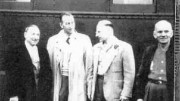—The following is an excerpt from Red Lake: Golden Treasure Chest, a new 164-page book by Michael Barnes chronicling the community and mines that have sprung up northwestern Ontario’s gold-rich Red Lake district. It’s available for $24.95 from General Store Publishing House, at tel. 1-800-432-7697 or www.gsph.com.
In ancient times, north of the sweet-water sea we now call Lake Superior, a band of Indian hunters met up with the Matchee Manitou on the shore of a large, lonely lake full of bays and islands. The discovery of the great mythic animal was fraught with danger, as it was believed the creature was the embodiment of evil.
Fortune was with the travellers; they slew the great beast and the legend of the event that survives to the present tells us that as their quarry died, its blood stained the waters red. They gave the lake its first name, Misque Sagaigan, “Blood Red Lake.”
Later visitors seem to have recognized this image. They named it Red Lake because they noted the rays of the setting sun did change the hue of the waters.
Europeans, mainly in the fur trade, first saw Red Lake in 1777, and for the next century, three companies vied for the native trade business. The lives of these first people and their contribution to northern lore, will be recognized properly later. The European new trader found a lake twenty-five miles long and averaging two miles in width. There were so many islands and the shoreline so indented that the total waterfront length was later found to cover 150 miles. The lake and surrounding area is recognized today as being located in the Kenora District of the Patricia portion of northwestern Ontario.
Surveyors and map-making parties followed on the heels of the fur trade. With the influx of visitors from afar, the peace experienced by the woodland caribou that ranged the land was at an end.
Geological Survey of Canada geologist Dr. Robert Bell, travelling west in 1872, was shown soapstone at Lac Seul. Since the soft stone can indicate the presence of sedimentary and igneous rocks, this could have suggested the possibility of gold in the area. A colleague, Dr. D. B. Dowling, explored the big lake in 1893 and reported that he had found interesting minerals. Dowling experienced that urge which first-time travellers often have to record their passing — he carved his initials in the rocks at Pipestone Bay at the northwest end of Red Lake.
Four years later, a British syndicate sent a party to explore for gold in this newly opened country. New Brunswick native Robert Gilbert led the group, which took the 192-mile land and water route inland to Red Lake from Dinowic on the CPR rail line.
The venture was confirmed as being worthwhile when they found gold in a decomposed vein near the lakeshore; they followed this up by staking eight claims.
Gilbert decided that they should return south with news of their find and engage a surveyor to verify the accuracy of their work, since the northwest had not yet been mapped by the province of Ontario.
As the party set out, Gilbert was the last man to get into the canoe. He reached for his belt and loaded revolver, which were still lying on the rocky shoreline shelf. In a freak accident, the weapon slipped from its holster and discharged, instantly killing Gilbert.
His grief-stricken and loyal companions ignored the summer heat, the arduous, long trail, and the prospect of numerous portages, and packed his body out to the railway, stopping first at Lac Seul to construct a rough box.
No doubt the surveyor set out to examine and map the claims was mindful of that sad misadventure as he made his way west. This was James William Tyrell (no relation to the famed Arctic explorer J. B. Tyrell). His follow-up party actually brought powder and blasted a twenty-five-foot shaft and found gold ore samples that assayed a splendid 0.6 ounces to the ton. However, nothing came of his report, as the area was remote, and another group that followed in 1912 abandoned the search after reaching the same conclusion.
–The author spent his career as an educator in Northern Ontario living in or near mining towns. He is a member of the Order of Canada and an Honorary Inspector in the OPP. He has written more that fifty books about everything from mining to policing, including this year’s More than Free Gold – Mineral Exploration in Canada Since World War II, also available from General Store Publishing House.




Be the first to comment on "Odds ‘n’ sods: The story of Red Lake"